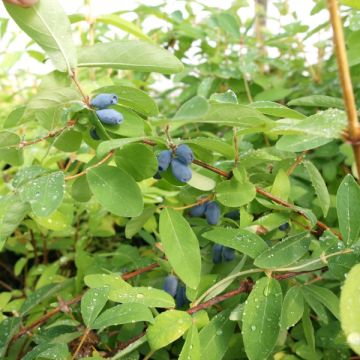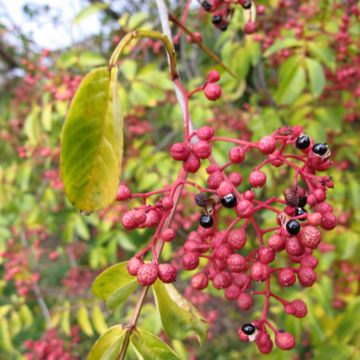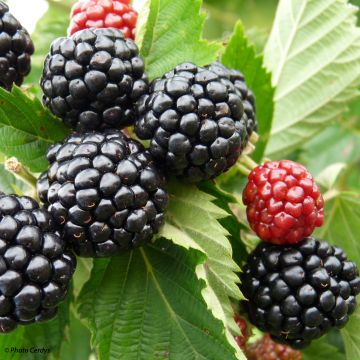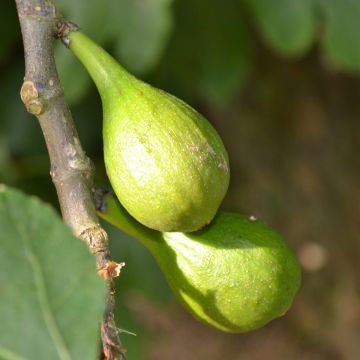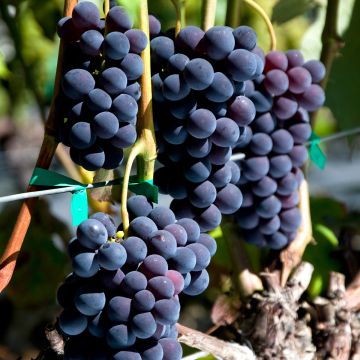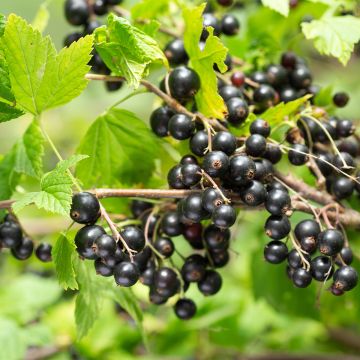

Lonicera kamtschatica Morena - May Berry
Lonicera kamtschatica Morena - May Berry
Lonicera kamtschatica Morena
Why not try an alternative variety in stock?
View all →This plant carries a 6 months recovery warranty
More information
We guarantee the quality of our plants for a full growing cycle, and will replace at our expense any plant that fails to recover under normal climatic and planting conditions.
From €5.90 for pickup delivery and €6.90 for home delivery
Express home delivery from €8.90.
Delivery to Corse prohibited: UE law prohibits the import of this plant from mainland France to Corse as part of the fight against Xylella fastidiosa. Please accept our sincere apologies.
More information
Description
Lonicera kamtschatica Morena, also known as Honeyberry Morena, is a semi-early variety that bears fruit in May. This slow-growing bush produces elongated, blue-purple berries, measuring 2 cm (1in) by 0.6 cm (0in) in diameter, called pruines. Rich in vitamins C and B, their flesh is tart and exceptionally fruity. The flavour of the berries is invigorating and falls somewhere between kiwi and blueberry. They can be enjoyed fresh or used in cooking. The unique bush, Lonicera kamtschatica Morena, should be planted in pairs for cross-pollination (with 'Fialka', for example). It is hardy down to -40°C (-40°F)!
Lonicera kamtschatica, or honeyberry, is an edible honeysuckle that has been known for a very long time by the indigenous people of the regions where it grows naturally, such as the boreal forests of Siberia and Northern Europe. It was first mentioned in the late 17th century by a Russian explorer, Vladimir Atlasov. Its cultivation in the northern regions of Russia began under the guidance of Peter Kuzmisev in the early 19th century. The first selections were made by Professor T. D. Mauritc to improve the fruit's taste qualities. In the 1950s, large-scale work continued on these initial selections, resulting in the creation of Lonicera kamtschatica Morena in 1995 in a Russian laboratory.
Lonicera kamtschatica belongs to the honeysuckle family. This compact variety of non-climbing honeysuckle does not exceed 1.30 m (4ft) in height. It can withstand very harsh temperatures, down to -40°C (-40°F), but on the other hand, it does not tolerate drought well. It does not like overly chalky soils. It has an upright and bushy habit, with numerous branches branching out in all directions from a slender 'trunk', giving the plant a compact appearance. Its foliage is deciduous. The bluish-green leaves are ovate and elongated, and they grow opposite each other. Its inconspicuous and unscented flowering occurs in March. The tubular flowers grow in pairs on the shoots and can withstand temperatures as low as -7°C (19.4°F). The fruits ripen at the end of May. They are elongated, approximately 2 cm (1in) long and 0.6 cm (0.2in) in diameter, weighing about 1g. Their skin is blackish with a waxy blue appearance.
The flowers, although hermaphroditic, are weakly self-fertile. Therefore, at least two plants are required to promote good fruiting. Pollination is entomophilous, with bumblebees and bees being recognized as its best pollinators.
The fruit is consumed fresh thanks to its delicious fruity flavor. It also adapts well to processing: jams, jellies, pastries, fruit juices, yogurts... When cooked, the fruit takes on a mahogany red colour.
Report an error about the product description
Plant habit
Fruit
Flowering
Foliage
Botanical data
Lonicera
kamtschatica
Morena
Caprifoliaceae
Russia
Other Berries A to Z
Planting and care
To plant Lonicera Kamtschatica Morena, choose a sunny or very bright location.
Space each plant about 1 m (3ft) apart.
Preparation: Dig a hole at least 50x50 cm (20in) and 40 cm (16in) deep. Mix compost or potting soil with the planting soil.
Planting: At the time of planting, add water to the bottom of the hole, as well as potting soil (about ten litres). When mixed, they will create a mud that Lonicera Kamtschatica will appreciate. The root ball should be moist. If necessary, soak it for a few minutes with its pot in a bucket of water. Remove the root ball from the pot and place it in the soil so that the top of the root ball is covered by 1 to 2 cm (0.5 to 1in). Firmly pack the soil around the root ball, forming a 'watering basin'. Always finish the planting with a generous watering. A few days after planting, apply mulch around the base, which you should be sure to maintain, especially in summer. Lonicera Kamtschatica Morena does not tolerate drought.
Planting period
Intended location
Care
-
, onOrder confirmed
Reply from on Promesse de fleurs
Berries
Haven't found what you were looking for?
Hardiness is the lowest winter temperature a plant can endure without suffering serious damage or even dying. However, hardiness is affected by location (a sheltered area, such as a patio), protection (winter cover) and soil type (hardiness is improved by well-drained soil).

Photo Sharing Terms & Conditions
In order to encourage gardeners to interact and share their experiences, Promesse de fleurs offers various media enabling content to be uploaded onto its Site - in particular via the ‘Photo sharing’ module.
The User agrees to refrain from:
- Posting any content that is illegal, prejudicial, insulting, racist, inciteful to hatred, revisionist, contrary to public decency, that infringes on privacy or on the privacy rights of third parties, in particular the publicity rights of persons and goods, intellectual property rights, or the right to privacy.
- Submitting content on behalf of a third party;
- Impersonate the identity of a third party and/or publish any personal information about a third party;
In general, the User undertakes to refrain from any unethical behaviour.
All Content (in particular text, comments, files, images, photos, videos, creative works, etc.), which may be subject to property or intellectual property rights, image or other private rights, shall remain the property of the User, subject to the limited rights granted by the terms of the licence granted by Promesse de fleurs as stated below. Users are at liberty to publish or not to publish such Content on the Site, notably via the ‘Photo Sharing’ facility, and accept that this Content shall be made public and freely accessible, notably on the Internet.
Users further acknowledge, undertake to have ,and guarantee that they hold all necessary rights and permissions to publish such material on the Site, in particular with regard to the legislation in force pertaining to any privacy, property, intellectual property, image, or contractual rights, or rights of any other nature. By publishing such Content on the Site, Users acknowledge accepting full liability as publishers of the Content within the meaning of the law, and grant Promesse de fleurs, free of charge, an inclusive, worldwide licence for the said Content for the entire duration of its publication, including all reproduction, representation, up/downloading, displaying, performing, transmission, and storage rights.
Users also grant permission for their name to be linked to the Content and accept that this link may not always be made available.
By engaging in posting material, Users consent to their Content becoming automatically accessible on the Internet, in particular on other sites and/or blogs and/or web pages of the Promesse de fleurs site, including in particular social pages and the Promesse de fleurs catalogue.
Users may secure the removal of entrusted content free of charge by issuing a simple request via our contact form.
The flowering period indicated on our website applies to countries and regions located in USDA zone 8 (France, the United Kingdom, Ireland, the Netherlands, etc.)
It will vary according to where you live:
- In zones 9 to 10 (Italy, Spain, Greece, etc.), flowering will occur about 2 to 4 weeks earlier.
- In zones 6 to 7 (Germany, Poland, Slovenia, and lower mountainous regions), flowering will be delayed by 2 to 3 weeks.
- In zone 5 (Central Europe, Scandinavia), blooming will be delayed by 3 to 5 weeks.
In temperate climates, pruning of spring-flowering shrubs (forsythia, spireas, etc.) should be done just after flowering.
Pruning of summer-flowering shrubs (Indian Lilac, Perovskia, etc.) can be done in winter or spring.
In cold regions as well as with frost-sensitive plants, avoid pruning too early when severe frosts may still occur.
The planting period indicated on our website applies to countries and regions located in USDA zone 8 (France, United Kingdom, Ireland, Netherlands).
It will vary according to where you live:
- In Mediterranean zones (Marseille, Madrid, Milan, etc.), autumn and winter are the best planting periods.
- In continental zones (Strasbourg, Munich, Vienna, etc.), delay planting by 2 to 3 weeks in spring and bring it forward by 2 to 4 weeks in autumn.
- In mountainous regions (the Alps, Pyrenees, Carpathians, etc.), it is best to plant in late spring (May-June) or late summer (August-September).
The harvesting period indicated on our website applies to countries and regions in USDA zone 8 (France, England, Ireland, the Netherlands).
In colder areas (Scandinavia, Poland, Austria...) fruit and vegetable harvests are likely to be delayed by 3-4 weeks.
In warmer areas (Italy, Spain, Greece, etc.), harvesting will probably take place earlier, depending on weather conditions.
The sowing periods indicated on our website apply to countries and regions within USDA Zone 8 (France, UK, Ireland, Netherlands).
In colder areas (Scandinavia, Poland, Austria...), delay any outdoor sowing by 3-4 weeks, or sow under glass.
In warmer climes (Italy, Spain, Greece, etc.), bring outdoor sowing forward by a few weeks.




































